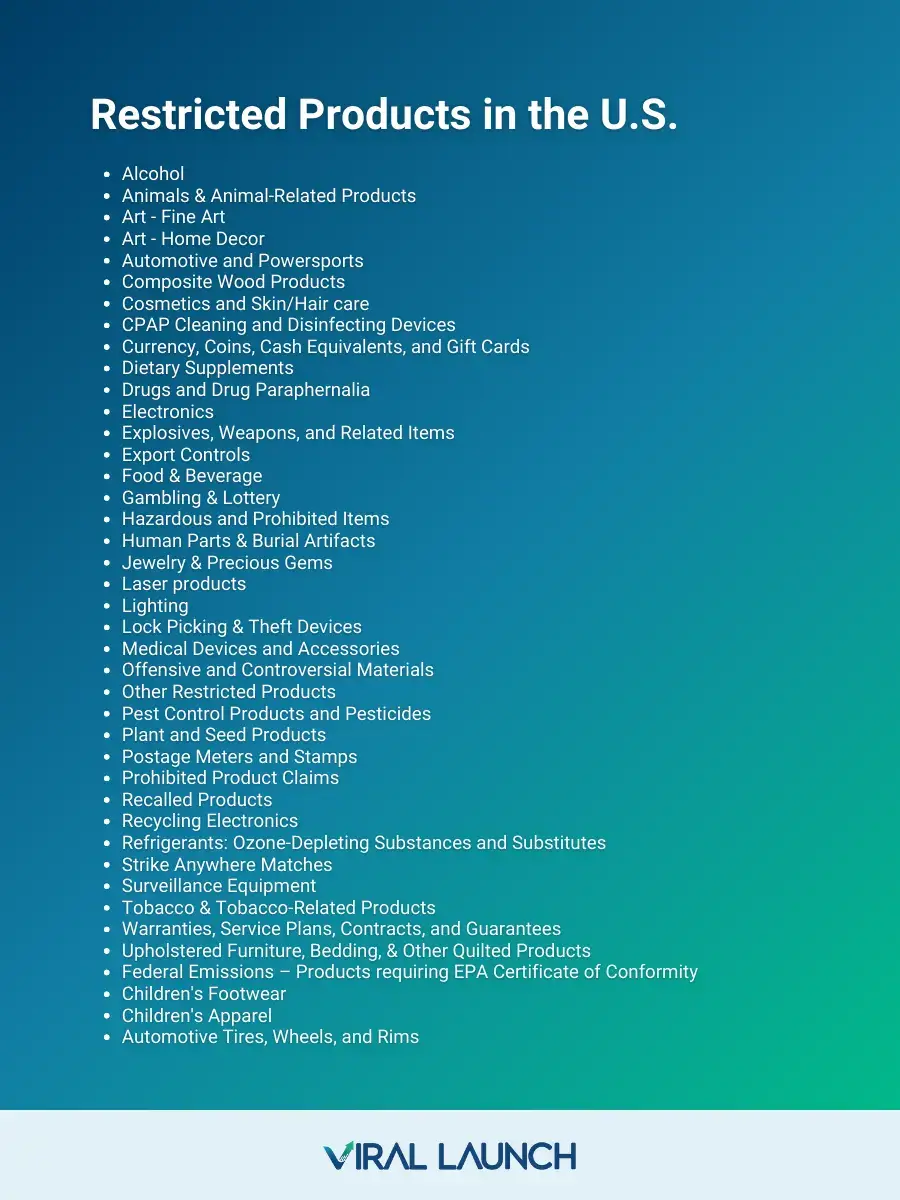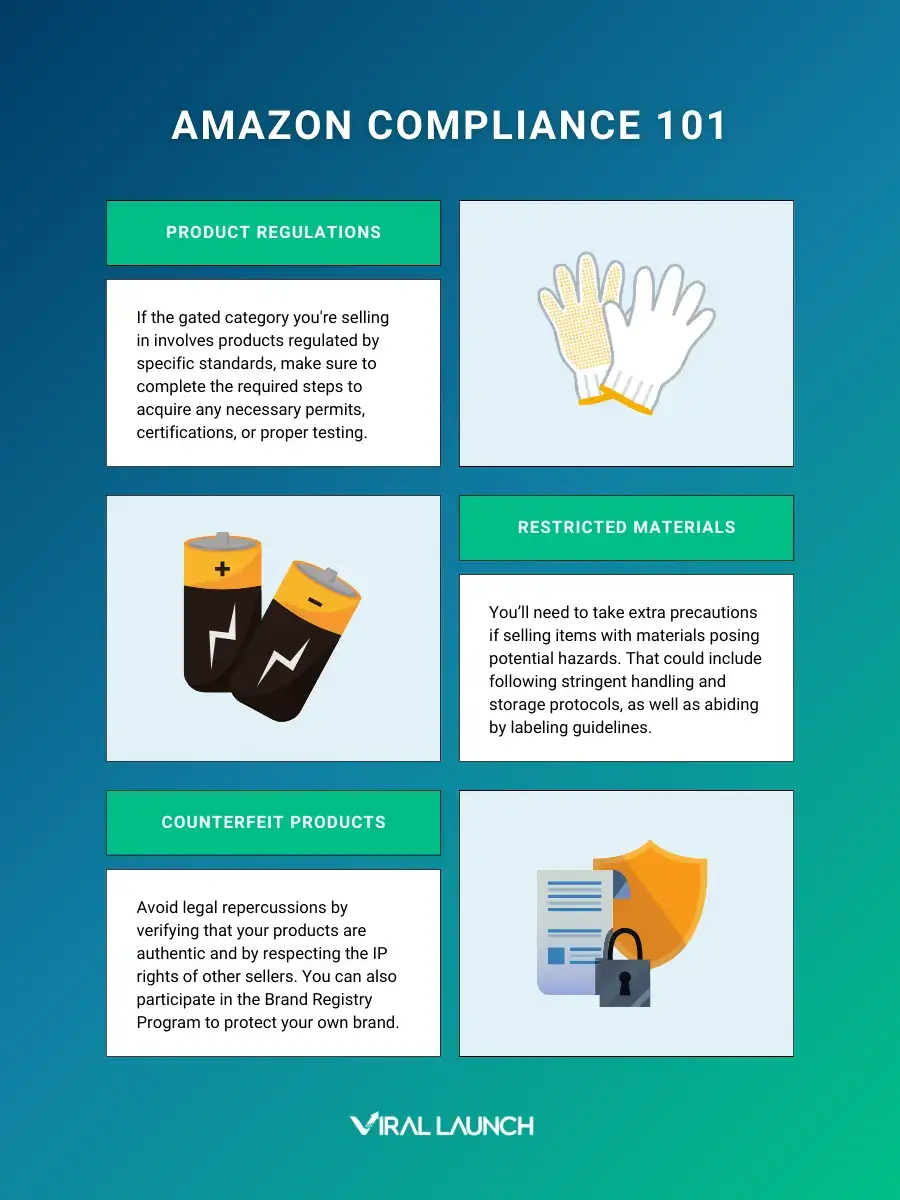If there’s one place to go to try your hand at making a profit, many e-commerce sellers will tell you Amazon. The platform caters to over 300 million active customers, a substantial audience to sell to. And with a solid product idea in hand, you could very well be on your way to success.
Of course, such a reward doesn’t come without great effort. You must dedicate time for product research, listing optimizations, and PPC campaign monitoring. Oh, and determine whether the category you’re selling in is gated.
Yep. Not all product categories are created equal—some require special approval to sell. If you don’t do your due diligence before sourcing a product in a gated category, you could be stuck with a ton of inventory and no way to move it.
To avoid this fiasco, we’ll go over what these restrictions entail and share tips on how to get ungated on Amazon.
The Basics of Amazon Gated Categories
What Does Gated Mean on Amazon?
When a product category is “gated” or restricted, a seller must get permission from Amazon to sell in it. This is the opposite of ungated categories, where you are free to list and sell your products without prior approval.
Why Does Amazon Have Gated Categories?
Two words: customer experience. At the end of the day, Amazon wants to remain in the good graces of its customers—especially with the rise of counterfeit products. That means cracking down on who can sell what in certain categories. This move protects buyers from sketchy third-party sellers and upholds the company’s reputation as a trustworthy e-commerce site.
What are the Benefits of Selling in Amazon Gated Categories?
Sure, getting the green light from Amazon to sell in a particular category involves extra steps. But it can pay off for the following reasons:
Less Competition
A stricter entry process can deter others from selling in these categories, ensuring you get a larger slice of the market.
Potential for Higher Profit Margins
Unlike ungated categories on Amazon, those requiring approval to sell often encompass unique or high-quality items. That can mean higher profit margins for you due to the exclusivity and perceived value of such products among buyers.
Greater Credibility
You’ve got a reputation to maintain as a seller. Going the gated route shows customers you’re committed to offering quality products and complying with the standards set for a specific category.
Which Amazon Product Categories are Gated?
This typically depends on the country you’re selling from. To keep things simple, here are the gated categories that U.S. sellers should be aware of in 2025:
- Postage Stamps
- Collectible Coins
- Fine Art
- Jewelry
- Join Amazon Subscription Boxes
- Made in Italy
- Music & DVD
- Services
- Sports Collectibles
- Streaming Media Players
- Video, DVD, & Blu-ray
- Watches
- Sony PlayStation Requirements in Video Games
For a general overview of the gated and ungated Amazon categories in the U.S., reference the table below. Note that while some don’t need approval, they may have specific subcategories that still do.
| Product Category | Conditions Allowed | Approval Required |
| Amazon Device Accessories | New, Certified refurbished, and Used | No, but there are selling guidelines. |
| Amazon Kindle | Used | No |
| Automotive & Powersports | New | No |
| Baby Products (excluding apparel) | New | No, but certain subcategories require approval. |
| Beauty | New | No |
| Books | New, Used, and Collectible | No, but there are condition guidelines for books. |
| Camera & Photo | New, Certified refurbished, and Used | No |
| Cell Phones & Accessories | New, Used, Certified refurbished; Unlocked | No, but there are selling guidelines. |
| Collectible Coins | Collectible-Like New | Yes, and there are selling guidelines. |
| Consumer Electronics | New, Certified refurbished, and Used | Listing in the Software, Video Games, and Consumer Electronics categories is generally open to all sellers, but certain other products may require pre-approval. Additional information on Consumer Electronics can be found here. For the condition guidelines on Consumer Electronics, go here. |
| Entertainment Collectibles | Collectible-Like New | Yes, and there are selling guidelines. |
| Fine Art | New (includes Primary and Secondary Sale artworks) | Yes, but new seller applications are limited. Review the general requirements for Amazon Fine Art. |
| Grocery & Gourmet Foods | New | No, but certain subcategories require approval. There are also selling guidelines to follow. |
| Health & Personal Care | New | No, but certain sub-categories require approval. |
| Home & Garden | New, Certified refurbished, Used, and Collectible | No |
| Independent Design | New | — |
| Industrial & Scientific | New, Certified refurbished, and Used | No, but there are selling guidelines. |
| Kindle Accessories and Amazon Fire TV Accessories | New, Certified refurbished, and Used | No |
| Major Appliances | New, Used, and Certified refurbished | No |
| Music and DVD | New, Used, and Collectible | Yes, and there are selling guidelines. |
| Musical Instruments | New, Certified refurbished, Used, and Collectible | No |
| Office Products | New, Certified refurbished, Used, and Collectible | No, but certain subcategories require approval. |
| Outdoors | New, Certified refurbished, and Used | No, but certain subcategories require approval. |
| Personal Computers | New, Certified refurbished, and Used | No, but certain subcategories require approval. |
| Pet Supplies | New, Certified refurbished, and Used | No, but certain subcategories require approval. |
| Software | New and Used | No, but may be required for specific products. |
| Sports | New, Certified refurbished, and Used | No |
| Sports Collectibles | Collectible-like new | Yes, and there are selling guidelines. |
| Tools & Home Improvement | New, Certified refurbished, and Used | No |
| Toys & Games | New and Collectible | No, but certain subcategories require approval such as Children’s toys. |
| Video, DVD & Blu-ray | New, Used, and Collectible | Yes, and there are selling guidelines. |
| Video Games | New, Used, and Collectible | No, but may be required for specific products. |
| Watches | New | Yes, and there are selling guidelines. |
Additional Restrictions To Keep in Mind
Besides Amazon’s restricted categories and subcategories, there are three other types of restrictions you may run into.
Product
Restrictions will vary depending on the item, but you can see which ones are on Amazon’s restricted products list below.

Just because an item is eligible to sell on Amazon, it doesn’t necessarily mean that it can be sold under FBA. There are separate requirements to follow for sellers using this fulfillment method. For more information, check out this help article to find out what’s considered an Amazon FBA-restricted product.
Condition
Certain categories may require you to detail the condition of the items you’re listing for sale. For instance, all products in the Watches category must be in New condition, whereas those in Pet Supplies can be in new, certified refurbished, or used condition. You can refer back to the table above for more information on how this restriction applies to each gated or ungated category.
Brand
For every Nike or Apple product, there could be hundreds, if not thousands, of knock-offs flooding the market. It’s the very reason why Amazon puts this restriction in place—to protect a brand’s value and prevent the sale of fraudulent items.
Note: You may find yourself in situations where a product is subject to multiple restrictions. In that case, you’ll need to submit separate applications for approval to sell.
How to Identify Gated Products on Amazon
The next step to nailing down Amazon seller-restricted categories is determining whether an item is gated. You can do so by looking up a product in the “Add a Product” section of Seller Central. Once you’ve found it in the search results, click on “Show Limitations.” If you see “Listing Limitations Apply,” the item is gated.
If what you plan to sell isn’t currently in Amazon’s store, simply search for a comparable item in “Add a Product.” Your listing will likely face the same restrictions as similar existing products.
How to Get Approval for Amazon Gated Categories
Now comes the fun part—obtaining the okay from Amazon to sell. Initiating the application process is pretty straightforward. In fact, you might recognize some of the steps from the previous section.
- Check that you’re in good standing to apply. You must have a Professional selling account and meet these performance metrics:
- Order Defect Rate: Less than 1%
- Late Shipment Rate: Less than 4%
- Pre-fulfillment Cancelation Rate: Less than 2.5%
- Sign into your Seller Central account.
- Head to the Inventory menu and select “Add a Product.”
- Perform a search for the product you want to sell.
- When the search results come up, click on the “Listing Limitations Apply” link.
- Choose “Request Approval” and begin the application. Be prepared to supply Amazon with additional requirements, such as:
- Paying an approval fee
- A company website
- A recent wholesale invoice, which includes details about your product and distributor’s name and address. It should also verify that your name and address match the ones listed in your seller account
- A letter from your supplier to prove product authenticity
- Other documentation that pertains to your gated Amazon product or category
Note: Although some sellers are approved within a few hours or days, it can take weeks or months for others.
What to Do if You Get Rejected
Don’t stress if Amazon denies your application. You can always reapply and increase your chances of getting approved by taking these measures.
3 Tips to Achieve Product Category Approval on Amazon
Build Up Your Experience
It’s not uncommon for Amazon to reject applications from newer sellers. To get some experience under your belt, we recommend selling in an ungated category before venturing into the gated ones. This will take time as you’ll want to boost your credibility, but as the saying goes, slow and steady wins the race.
Choose Local Suppliers
Amazon has a track record of not accepting invoices from manufacturers abroad, which is not something you want when trying to gain approval. Therefore, we strongly advise you to source your products domestically.
Do Your Research
We can’t stress this one enough. If you skip out on learning the ropes of Amazon’s category restrictions, you could unknowingly violate one (or more) of them. Sellers who don’t adhere to the rules could face having their listings canceled. Even worse, listing privileges could be limited, suspended, or removed altogether.
Getting reinstated after receiving disciplinary action is a beast of its own, so it’s best to stick to Amazon’s compliance policies the first time around.

A Quick Word on Amazon Ungating Services
They exist and are meant to help sellers navigate getting ungated. However, they are not affiliated with Amazon and don’t guarantee the approval of your application. We suggest you try going through the process yourself before turning to one of these services.
Final Thoughts
Selling in a gated Amazon category is no small feat, but it can be well worth it in the end. When you go the extra mile to get ungated, you up your chances of beating out others hesitant to seize such opportunities. Pair that with favorable profit margins and greater trust among customers, and you’ve got yourself a surefire recipe for a profitable Amazon business.
The process will take some patience and perseverance, but in due time, you’ll get to reap the rewards.








